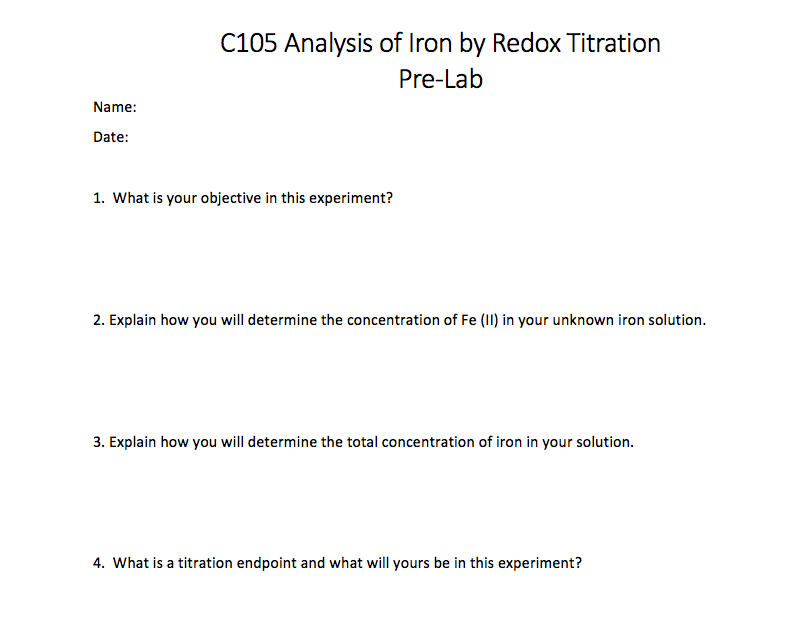CHEM120L Lecture Notes - Lecture 2: Molar Mass, Sodium Hydroxide, Titration
Document Summary
Get access


Related textbook solutions
Chemistry: Structure and Properties
Basic Chemistry
Principles of Chemistry Molecular Approach
Chemistry: Structure and Properties
Principles of Chemistry Molecular Approach
Chemistry: A Molecular Approach
Chemistry: A Molecular Approach
Principles of Chemistry: A Molecular Approach
Chemistry: The Central Science
Related Documents
Related Questions
| 1.) average number of moles of NaOH dispensed |
|---|
| 2.)average concentration of the acid (mol/L) |
|---|
3,) Based on your coarse titration volume, do you expect the acetic acid solution to have a higher or lower concentration than the NaOH solution?
| higher could you please tell me if number 3 is right |
please help with these 2 questions
Part 1: Prepare the NaOH Solution
Lab Results
How many mL of water were used to prepare the NaOH solution?
| 200mL |
Data Analysis
Calculate the molarity of the NaOH solution. The molar mass of NaOH is 39.997 g/mol.
| 0.1M |
Calculate the amount of benzoic acid to be neutralized by 20.00 mL NaOH solution, in both moles and grams. The molar mass of benzoic acid is 122.12 g/mol.
| 1.207 g |
Part 2: Perform a Coarse Titration
Lab Results
Record the following data from your course titration in the table below.
| mass of benzoic acid used (g) | 0.26614g |
|---|---|
| pH of benzoic acid solution before titration | 2.96 |
| volume of NaOH in the burette before titration (mL) | 50.0mL |
| volume of NaOH in the burette after titration (mL) | 28.89mL |
| volume of NaOH dispensed in the titration (mL) | 21.11mL |
Data Analysis
How do you expect your coarse titration volume to compare to your fine titration volumes?
| I expect the values to be a little off from each other since in the first titration we let out a lot at a time and didnt slowly do the titration. should only be off by a few mL. |
Part 3: Perform Fine Titrations
Lab Results
Record the volume of NaOH solution dispensed in the 3 fine titrations.
| 20 mL dispenced ,20.34mL, 20.30mL |
Data Analysis
Calculate the average concentration of the NaOH solution, using the average volume of NaOH solution dispensed in the 3 fine titrations. Report your answer using enough significant figures to distinguish it from the expected concentration of 0.100 M.
| V = (V1 + V2 + V3) / 3 V = (20.03 mL + 20.06 mL + 20.02 mL) / 3 = 20.04 mL M = n / V = 0.00200 moles / 0.02004 L = 0.0998 M Learning objective: Determine the concentration of a solution. 20.21= ----> 0.0999M |
Experiment 2: Use the Standardized NaOH Solution to Determine the Concentration of an Acid
Part 1: Perform a Coarse Titration
Lab Results
What was the pH at the end point of the coarse titration?
| 3.87ph |
Data Analysis
Based on your coarse titration volume, do you expect the acetic acid solution to have a higher or lower concentration than the NaOH solution?
| higher |
Part 2: Perform Fine Titrations
Lab Results
For the 3 fine titrations of the acid of unknown concentration, fill in the following data.
| Titration #1 | Titration #2 | Titration #3 | |
|---|---|---|---|
| volume of acid (mL) | 59.11 | 40.97 | 40.98 |
| volume of NaOH dispensed (mL) | 9.05 | 9.03 | 9.02 |
Data Analysis
Calculate the following quantities and record the data in the table below.
| average volume of NaOH solution dispensed (mL) | 9.03 |
|---|---|
| average number of moles of NaOH dispensed | |
| average concentration of the acid (mol/L) |
Conclusions
Phenolphthalein is pink over the range of pH 8 â 12. Why was it a useful indicator of when the equivalence point was reached?
| This was helpful because once I got to the ph of 7 I knew that I would be getting closer to the end point which would change the color to pink. |
Suppose a student titrated a sample of monoprotic acid of unknown concentration using a previously standardized solution of NaOH.
| volume of 0.125 M NaOH dispensed | 24.68 mL |
|---|---|
| volume of acid solution | 50.00 mL |
Given the data in the figure above, what is the concentration of the unknown acid?
| 0.0617M Lab NOTES: ex1 Take sodium hydroxide from the Materials shelf and add 0.800 g to the beaker. Take water from the Materials shelf and add 200 mL to the beaker. Ph 2.96 inital volume in burett inital volume 50ml 1.) volume43.78mL volumes dispenced =6.22ml 2. volume =38.05 volume dispenced =11.95ml 3.)volume = 32.06 volume dispenced=17.94 4.28.89ml volume dispenced=21.11ml ph=10.95 -------------------------------------- Ex 2 inital ph= 2.96 volume30.33 dispence 20.05 1. volume 39.92ml volume dispenced=10.08 2.volume 29.66 voiume dispence 20.34 final ph10.43 initial valume in burett 50ml -------------------- ex3 final ph9.43 volume 30.28 volume dipenced=20.00 ---------------------------------------------------------------------- 2nd Ex initial ph 3.11 volume 50 1. volume 48.95mL dispenced 1.05mL ph 3.87 2. volume 45.88 dispenced 4.12 ph 4.67 3 volume 42.99 dispenced 7.01 ph 5.29 4 volume 39.93 dispence 10.07 ph 11.45 -------------------- F1 final ph 9.99 volume 59.11 dispenced 9.05 F2 ph 9.59 volume 40.97 dispenced 9.03 f3 ph 9.50 volume 40.98 9.02 |

